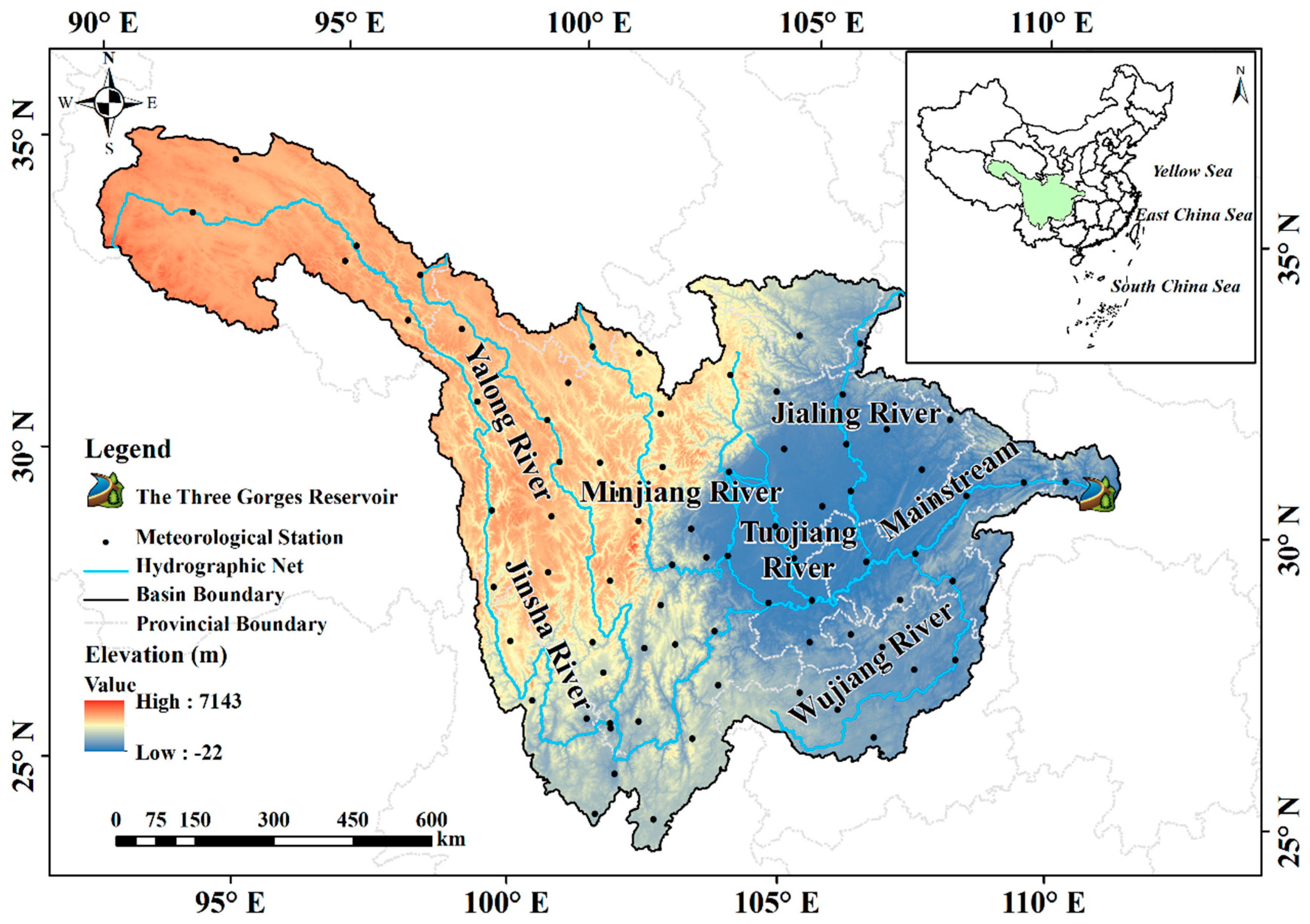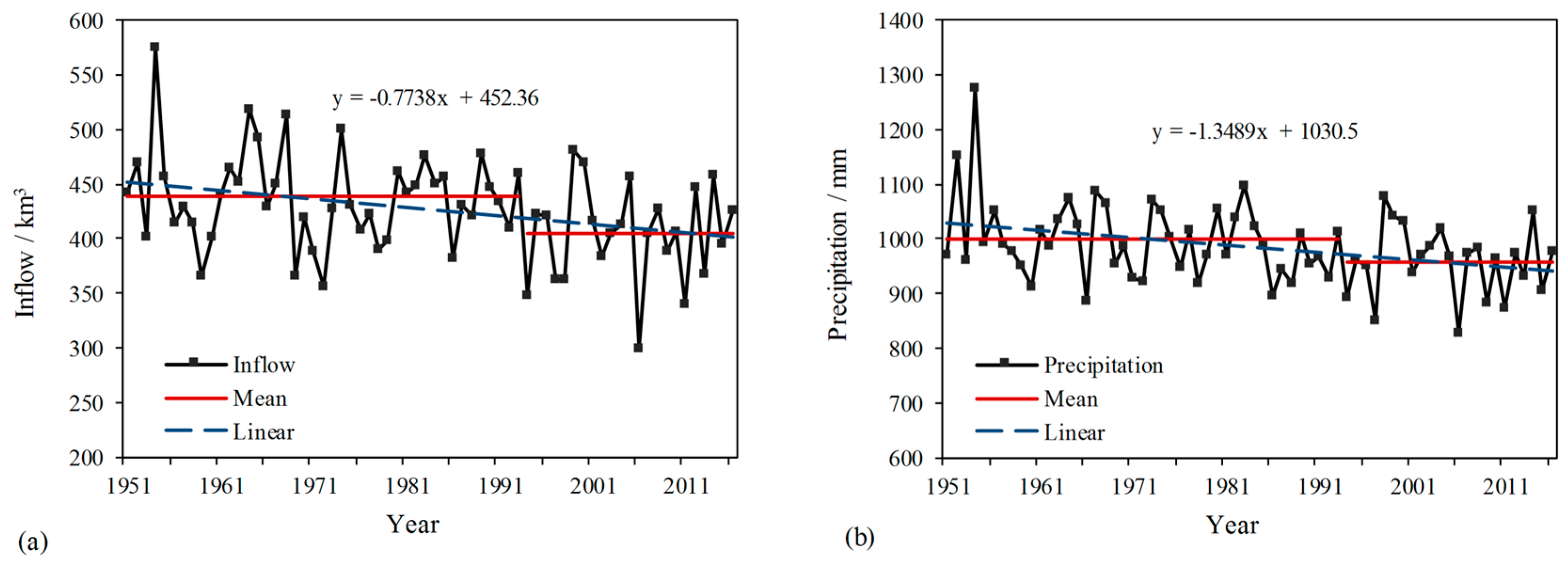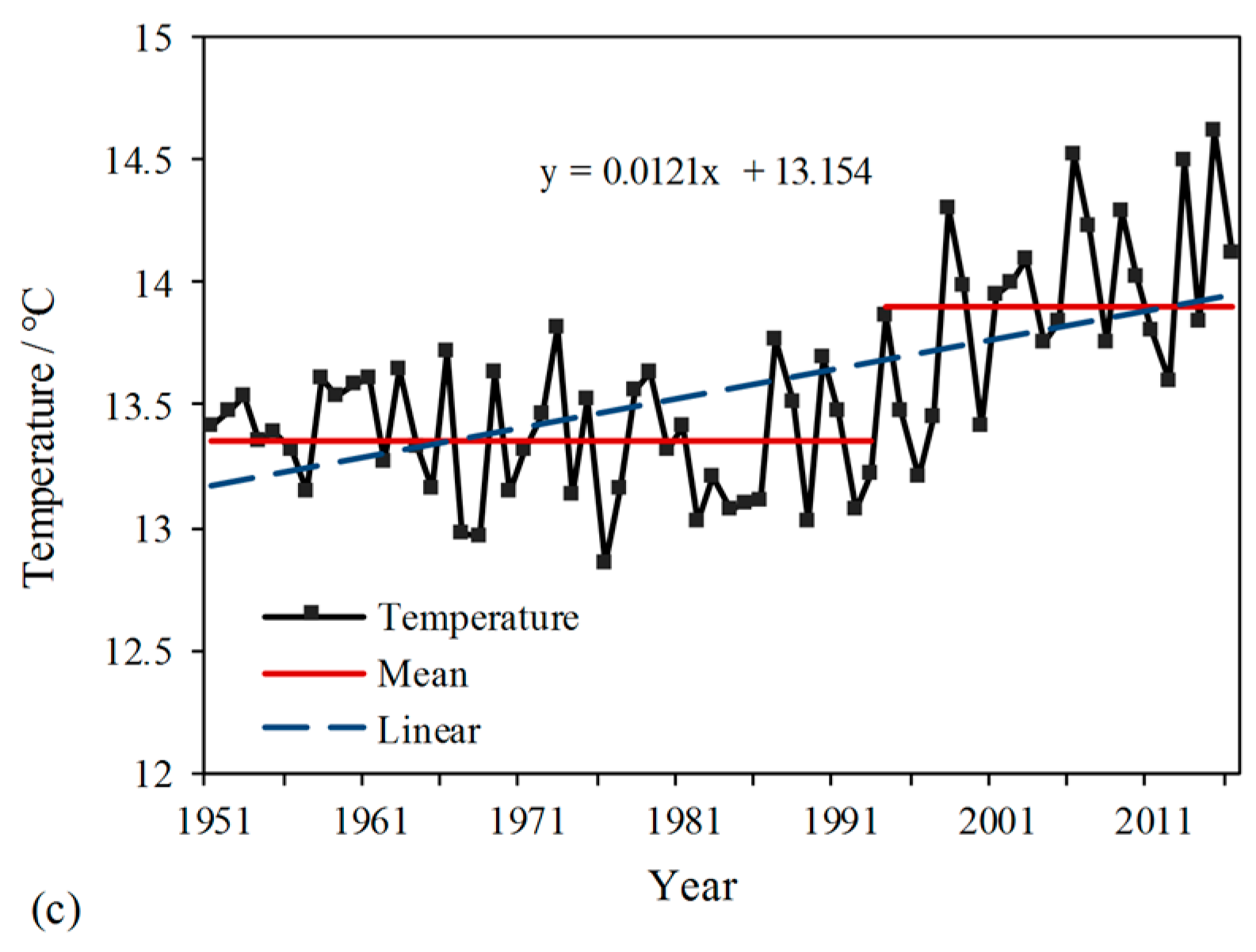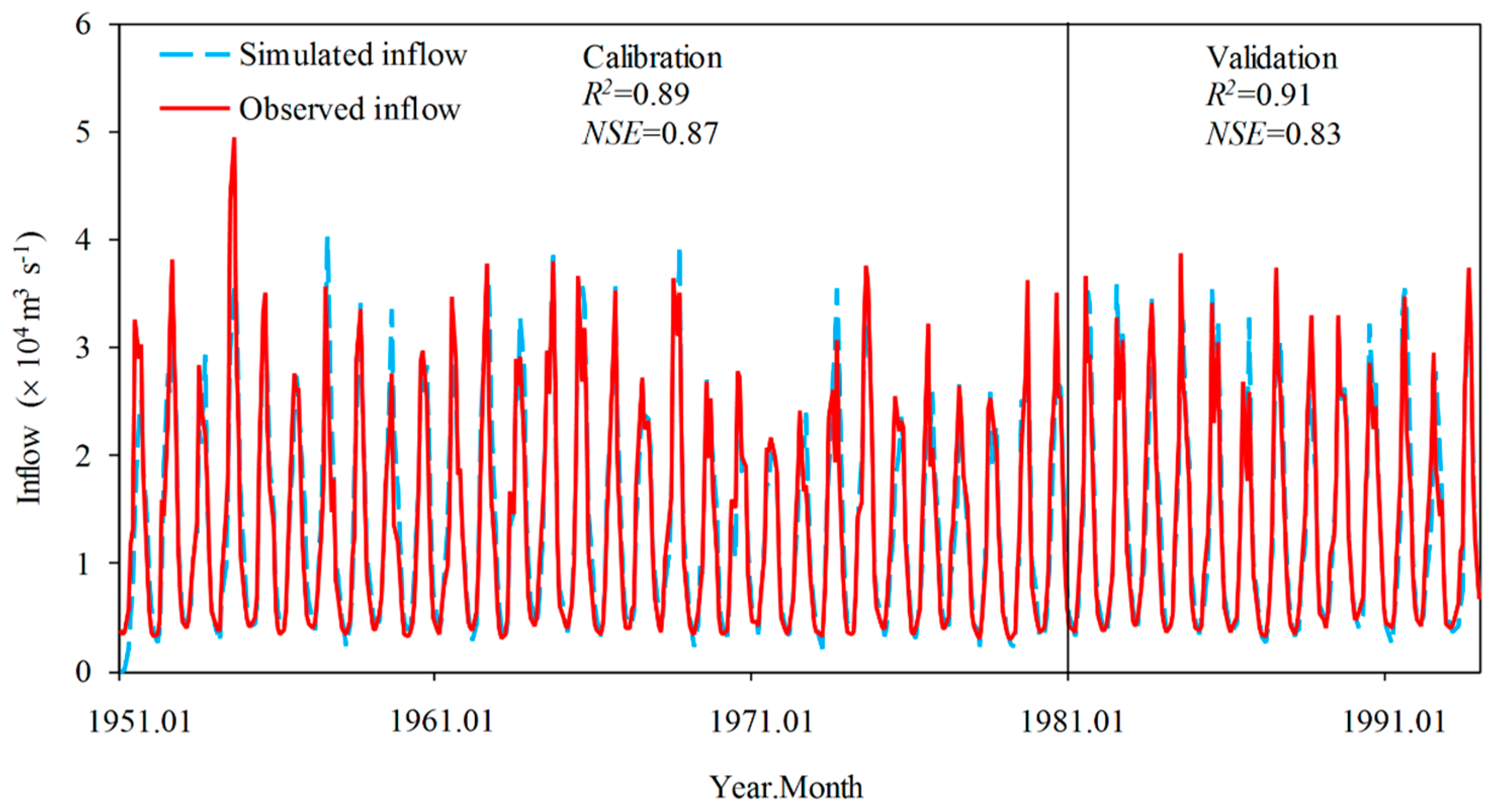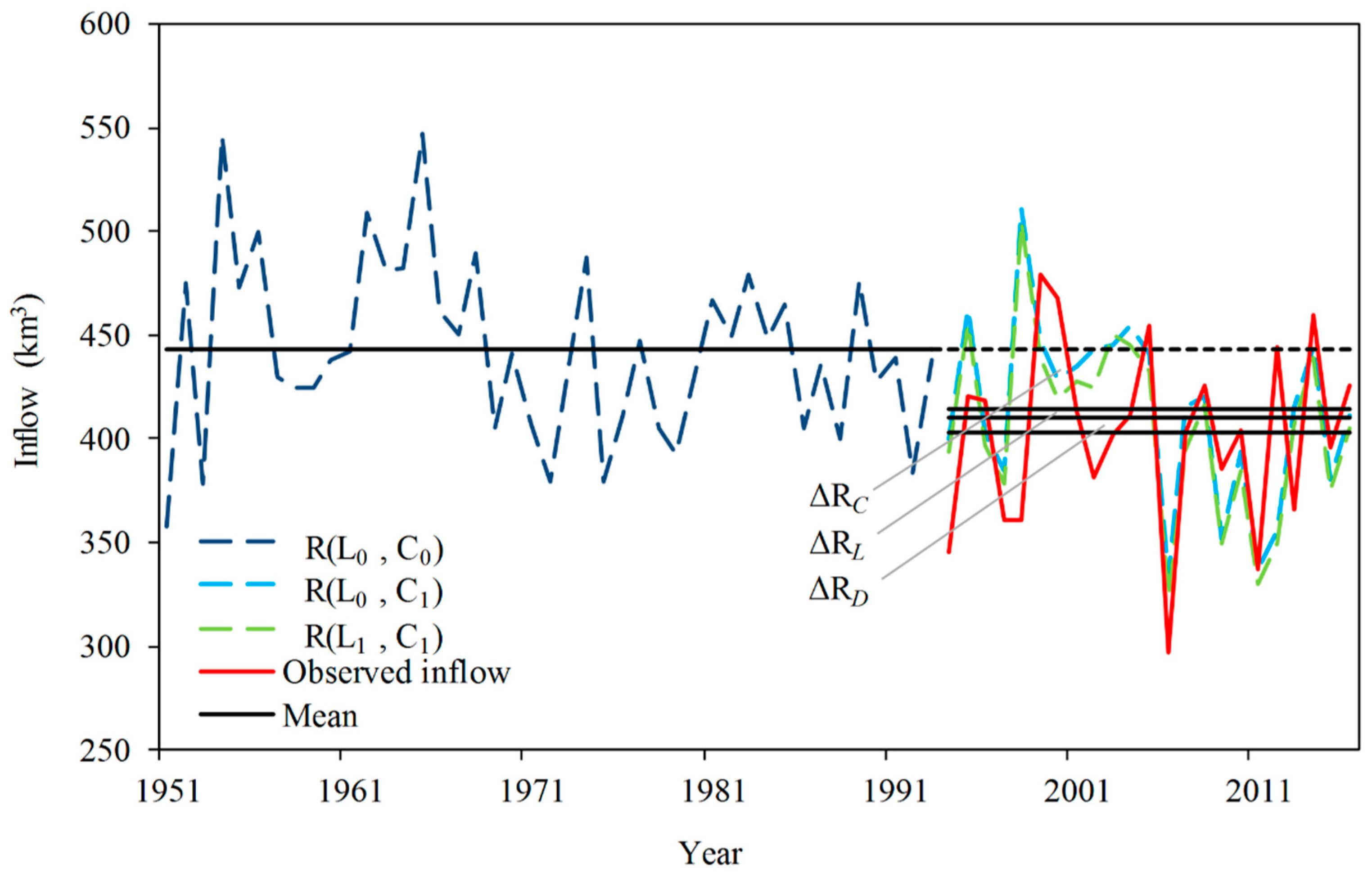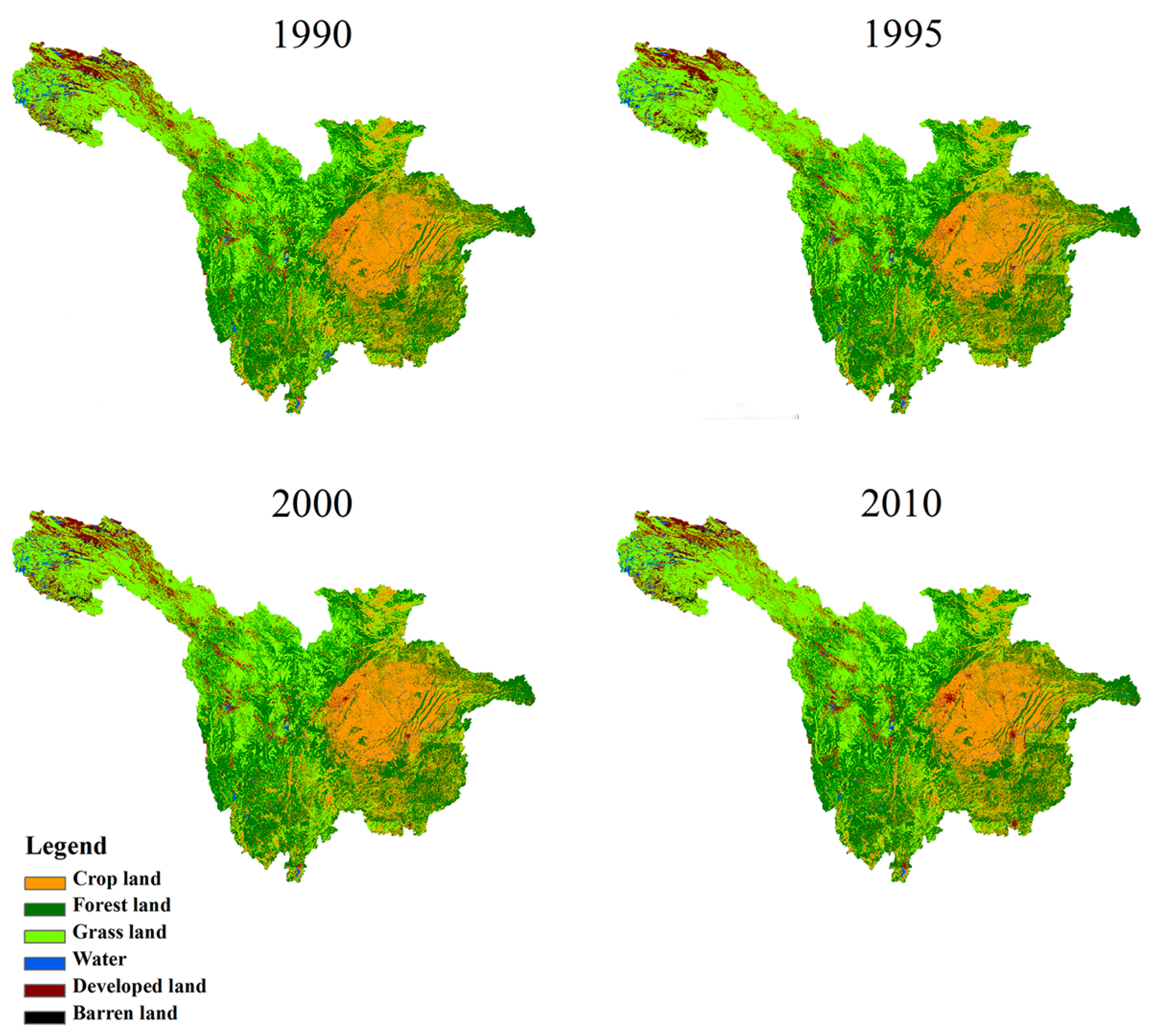1. Introduction
Affected by global warming, the hydrological cycle is accelerating [
1]. Meanwhile, intense human activities, for instance, land use/cover change (LUCC) and wholesale water projects, profoundly affect the hydrological processes [
2,
3]. Uncertainty of the hydrological processes is aggravated due to both climate change and human activities [
4]. Identifying the changes in the runoff and attributing the changes to various driving factors have become one focus in water science [
5].
In recent years, several studies have been conducted to assess impacts of changing environment on runoff [
6]. Impacts of climate change and human activities on runoff have different manifestations across the world. In some watersheds, impact of climate change is greater than that from human activities, while other watersheds are the opposite. Reviewing extensive literature, quantitative methods used to assess impacts from climate change and human activities on runoff generally fall into two categories: statistical methods and simulated methods. Statistical methods are based on observed data, while simulated methods are based on various hydrological models, and have gone through a transformation from methods based on lumped hydrological models to methods based on distributed hydrological models.
Statistical methods generally use regression to assess impacts on runoff based on observed meteorological data and hydrological data. The regression is established between runoff and one or more meteorological factors. For example, Revelle and Waggoner [
7] used a multiple regression to assess impact of climate change on runoff in the upper reaches of the Colorado River. The climatic elasticity method, which was first proposed by Schaake [
8] and continually extended, is another classic method. These statistical methods have some simple principles and are easy to use. However, these methods are based on, and limited to, the data series, because longer series bring better regression. Data uncertainty and number of driving factors used surely could influence the results. Apart from the impacts from climate change, the rest changes in runoff are attributed to human activities. Such methods have not explained in what way, how much, and how human activities factors influence the runoff, which greatly reduces the reliability of the analysis results.
The hydrological processes are very complex and highly non-linear. Models based on the linear system theory generally fail to represent the non-linear processes [
9]. During the history of hydrological models, many famous and excellent lumped hydrological models sprang up, for instance, Tank model [
10], Stanford watershed model [
11], and Xinanjiang model [
12]. These models consider the processes from runoff generation to runoff concentration and have a certain summary of specific ones including precipitation, evapotranspiration, infiltration, surface runoff, groundwater discharge, and so on. The lumped hydrological models often regard a watershed as a whole, and spatial variations are rarely taken into account. There are many empirical formulas in the models which lack explicit physical meanings. Lumped hydrological models are used to assess impacts from climate change and human activities on runoff in various watersheds across the world because of simplicity [
13,
14]. Compared to other hydrological models, distributed hydrological models can describe mechanisms of hydrological processes as well as spatial heterogeneity. With the help of reams of information obtained from Geographic Information System and Remote Sensing, distributed hydrological models are generally effective and accurate to simulate the hydrological processes. As a result, distributed hydrological models are more effective to assess impacts from climate change, LUCC and other human activities [
15]. The Soil and Water Assessment Tool (SWAT) is a representative one. SWAT is a river basin or watershed model that has been widely used to predict flow, sediment, and agricultural chemical yields from watersheds of various sizes, particularly in large, complex watersheds. It is the most vigorous method for simulating the long-term impacts of watershed management (e.g., dam building, timber harvesting, and irrigation) on hydrologic process [
16].
In China, economy is booming. The great developments in agriculture and industry, together with the climate change, have caused varying degrees of changes in hydrological processes [
17]. The Three Gorges Reservoir is currently the largest water conservancy project in the world and attracts flocks of scholars and researchers. Runoff in the upstream Yangtze River flows into the Three Gorges Reservoir in the form of reservoir inflow finally. Great changes have been observed in the Three Gorges Reservoir inflow [
18]. However, limited studies have been conducted to seek the specific reasons and assess the impacts. This study selects the changing Three Gorges Reservoir inflow as the study case and assesses the impacts from climate change and human activities on it by using SWAT. In previous studies, when assessing impacts on runoff via the SWAT, land use/cover (LULC) is considered stable during a certain period, and one piece of LULC map is enough to represent the period [
16,
19]. However, it is always being blurred and muddled how long the period should be. The two-stage method and the multi-stage method are two parties holding different opinions. Both methods are based on the premise that LULC remains stable during a certain period. Divergence between the two is how long the certain period continues. LULC is considered stable during a long period, while the stable condition lasts shorter in the multi-stage method. Both methods are discussed in this study.
2. Study Area and Data
The Three Gorges Reservoir is located at the mainstream of the Yangtze River, in Yichang City, Hubei Province. It has a total storage of 3.93 × 10
10 m
3 and a total installed capacity for the hydraulic turbines of 2.25 × 10
7 kW. It is a multi-purpose water conservancy project, including flood protection, electric power generation, shipping, water supply, recreation, and ecological protection. In this study, the upstream Yangtze River is selected as the study area. As shown in
Figure 1, the study area is located in the region within 97.37° E–110.18° E and 21.13° N–34.33° N, with a total area of 1 × 10
6 km
2 covering nine provinces. The elevation of study area ranges from −22 to 7143 m.
Daily inflow series from 1951 to 2016 is obtained from the China Three Gorges Corporation. Daily meteorological factors series from 80 National Meteorological Observatory (NMO) stations within the study area are collected from the National Meteorological Information Centre of China (NMIC) (
http://data.cma.cn), including daily precipitation, mean air temperature, maximum air temperature, minimum air temperature, sunshine duration, mean wind speed, and mean relative humidity. Soil type data (with a scale of 1: 1,000,000) and LULC data (with a scale of 1: 100,000 for late 1980s, 1995, 2000, 2010) are provided by the Data Center for Resources and Environmental Sciences, Chinese Academy of Sciences (RESDC) (
http://www.resdc.cn). In addition, a Digital Elevation Model (DEM) with a spatial resolution of 90 m × 90 m is obtained from the Consultative Group on International Agricultural Research (CGIAR) Consortium for Spatial Information (CGIAR-CSI) (
http://srtm.csi.cgiar.org).
4. Changes in Reservoir Inflow, Precipitation and Temperature
The annual reservoir inflow shows a decreasing trend with a slope of −7.7 km
3 per ten years during the study period (
Figure 3a). Both the simple linear regression method and the Mann–Kendall test indicate that this decreasing trend is remarkable with a confidence level of 95%. The annual total precipitation up the Three Gorges Reservoir shows a decreasing trend with a slope of −13.5 mm per ten years (
Figure 3b), whereas the annual mean temperature shows an increasing trend with a slope of 0.1 °C per ten years (
Figure 3c), which is in accordance with the context that global temperature increased by 0.7 °C during the last one hundred years [
27]. It also can be seen in
Figure 3 that there is a strong positive correlation between precipitation and reservoir inflow, while temperature is negatively correlated to the reservoir inflow.
The non-parametric Pettitt’s test is used to detect the occurrence of an abrupt change point in the Three Gorges Reservoir inflow, and the sequential clustering method is used to further confirm the break point identified by the Pettitt’s test. Both methods indicate that the year 1993 is the abrupt change point. The reservoir inflow is considered less affected by climate change and human activities before the abrupt change point and changes obviously. Accordingly, the study period can be divided into pre-change period and post-change period (i.e., 1951–1993 and 1994–2016) by the change point. The means, standard deviations and coefficient of variation of the annual reservoir inflow, precipitation and temperature in the two periods are analyzed to better understand the characteristics of changes in the reservoir inflow and climate (
Table 1). The mean of annual reservoir inflow for the post-change period relative to that for the pre-change period decreases 7.7%, indicating large decrease in the annual inflow during the post-change period. Statistically significant differences between the means of two periods can be found with a confidence level of 99% using the
t-test, whereas using the
F-test, differences between the standard deviations of the two periods are not statistically significant. In addition, the increasing coefficient of variation of the reservoir inflow indicates that the inflow varies more in the post-change period than in the pre-change period. This change in the coefficient of variation is in accordance with facts that human activities are becoming more complex and greater [
18]. As for precipitation and temperature, statistically significant differences between the means of two periods are also found at a 95% confidence level using the
t-test. The mean of annual precipitation for the post-change period relative to that for the pre-change period decreases 4.5% and temperature increases 3.7%, whereas, using the
F-test, differences between the standard deviations of the two periods are not statistically significant. Comparing with the pre-change period (i.e., 1951–1993), the Three Gorges Reservoir inflow is at a low level in the post-change period (i.e., 1994–2016), as well as the precipitation, whereas the temperature is at a high level.
5. Reservoir Inflow Simulation
Sensitivity analysis is performed to evaluate the effect of parameters on the performance of the model in runoff simulation. Based on the sensitivity analysis, eleven highly sensitive parameters are selected and calibrated (
Table 1). The pre-change period is divided into calibration period from 1951 to 1980 and validation period from 1981 to 1993. The LULC map of the late 1980s is used as the LULC input for calibration and validation. Calibrated values for the eleven parameters are also listed in
Table 2. Simulated and observed inflow during the calibration and validation period are plotted in
Figure 4.
Moriasi et al. [
28] suggest that
NSE values greater than 0.75 are considered excellent, values greater than 0.65 are considered good, and values greater than 0.5 are considered satisfactory for hydrological model evaluation. They further conclude that
R2 values greater than 0.5 are regarded as acceptable for model simulation. Values of
R2 and
NSE are 0.89 and 0.87 for the calibration period, indicating an excellent calibration simulation; values of
R2 and
NSE are 0.91 and 0.83 for the validation period, indicating an excellent simulation beyond the pre-change period.
6. Quantitative Assessment Analysis
One piece of LULC map is a composite of dozens of pictures taken by the orbiting satellite. Limited to track of the orbiting satellite, every picture is taken sequentially. As a result, there is an interval of about several years between pieces. Different from changes in erratic weather or subjective water diversion, LULC are sometimes considered accumulative and chronic [
16,
19,
29,
30]. The two-stage method and multi-stage method are both based on the premise that LULC remains stable during a certain period. Divergence between the two is how long the certain period continues. In the procedure of the two-stage method, LULC is considered stable during the whole post-change period, while the stable condition lasts shorter in the multi-stage method.
One piece of LULC map in each stage is enough for quantitative assessment. The map in the late 1980s has been used to represent LULC condition during the pre-change period (the first stage). As for the two-stage method, the LULC map in 2010 is used to represent the condition during the whole post-change period (the second stage). The inflow
R(
L0,
C1) and
R(
L1,
C1) during the post-change period mentioned above are simulated by the built SWAT model and plotted in
Figure 5, as well as the simulated inflow during the pre-change period and observed inflow during the post-change period. Changes in the Three Gorges Reservoir inflow can be attributed to climate change, LUCC, and direct human activities by the steps introduced above. They are −30.5 km
3, −4.8 km
3, and −8.3 km
3, accounting for 70%, 11%, and 19%, respectively (
Table 3).
When LULC condition changes a lot during the post-change period, the multi-stage method is superior to the two-stage method, because it can describe the impact of temporal and spatial variation of LULC condition on the reservoir inflow. However, the boundaries between changing a little and changing a lot are always being blurred and muddled. There has not been a clear criterion on whether the two-stage method or the multi-stage method performs better in a certain situation. In this study, LULC from the late 1980s to 2010 are compared and
Figure 6 displays the historical LULC maps for the study area. The overall LULC has changed “little” between the historical maps, except some local obvious changes. The areas and percentages of LULC types during the four different periods are shown in
Table 4.
In area up the Three Gorges Reservoir, the most major LULC types are grass land, forest land, and crop land, accounting for more than 90% of the total area. Changes in the areas of different LULC types range from −4 to 4 × 10
3 km
2. “Little changes” in areas of LULC types often become the basis of the previous studies, which suggested that LULC condition changed slowly and the two-stage method could be used [
27]. Although “little changes” are detected in areas of different LULC types, there are abundant transformations between different types, indicating the spatial variation of LULC (
Table 5). For the crop land, 65.5% of crop land in 1990 is unchanged in 2010, while 34.5% turns into other types. These transformations are involved in most part of the hydrological process from runoff generation to concentration and cause changes in the Three Gorges Reservoir inflow finally [
31,
32]. Therefore, the multi-stage method could be more suitable for assessing the impact of LUCC.
To consider the temporal and spatial variation of LULC, the multi-stage method is also used to assess the impact on the Three Gorges Reservoir inflow. Before quantitative calculations, the post-change period must be divided into some shorter stages. The temporal pattern studied above shows a mixed level of both high and low amount of inflows, where 1994–1997 shows a low level, 1998–2005 shows a high level and 2006–2016 shows a low level (
Figure 3a). According to the temporal pattern, the post-change period can be divided into three stages (i.e., 1994–1997, 1998–2005, and 2006–2016). The LULC maps of 1995, 2000, and 2010 are used as the LULC inputs for the three stages in the post-change period, respectively. Following the steps of the multi-stage method introduced above, changes in the Three Gorges Reservoir inflow can be attributed to climate change, LULC, and direct human activities for every stage. The calculation results are listed in
Table 6.
7. Comparison between Two- and Multi-Stage Method
To test impact of the number of stages on assessing quantitative assessment, and obtain credible attribution results, both two- and multi-stage method are used in this study. For ease of comparison, impacts of climate change, LUCC, and direct human activities for every stage are accumulated. The accumulated results are listed in
Table 7, as well as the results of the two-stage method. It can be seen that assessment of impacts on the Three Gorges Reservoir inflow via the two methods are close in results. For the multi- stage method, the contribution of climate change in stage 1994–1997 and 1998–2005 is larger than that in two-stage method (
Table 6). Because impact of LULC and other human activities are accumulated stage by stage, and impact of climate is related to difference of meteorological factors between stages. It is noteworthy that there are some abrupt changes in different stage results of multi-stage method. LUCC during the stage 1999–2005 result in increased reservoir inflow, which are different from the general characteristics. However, it is virtually impossible to make an obvious change in LULC condition in a short time. Different from the chronic climate change, the LULC condition is usually affected by policy at the time.
In recent decades, intense human activities up the Three Gorges Reservoir have had profound effects on the reservoir inflow [
18]. Therefore, it is particularly important to fully consider the human activities either directly or indirectly related to water when identifying and analyzing the changes in the Three Gorges Reservoir inflow.
For the term ΔR
L, LUCC have lasting impacts on runoff. Until the end of 2010, up the Three Gorges Reservoir, 13,000 reservoirs have been built, which have a total storage of 56 km
3. Evaporation from water surface is usually greater than that from land surface. Therefore, increasing water area caused by constructions of reservoirs results in increasing evaporation. Mean annual actual evapotranspiration in the Yangtze River basin is 520 mm and mean annual pan evaporation is 1400 mm [
33]. Moreover, evaporation from airy and open water surface is greater than the pan evaporation. Therefore, increase in actual evaporation caused by constructions of reservoirs could be estimated at 1 m per year. As shown in
Table 4, area of water increased by 4 × 10
3 km
2 from 1990 to 2010. Under the above conditions, 4 km
3 of the Three Gorges Reservoir inflow is lost due to the increased actual evaporation. After 2010, more and more reservoirs are planning to be constructed, and the loss of water is increasing.
For the term ΔR
D, some human activities get involved with runoff directly, for instance, reservoir impoundment, domestic and industrial water supply inside the watershed, water diversion towards other watersheds. These human activities have great and direct impacts on runoff [
34]. Reservoir impoundment is used as an example. It is mentioned in the prior context that, until the end of 2010, reservoirs built up the Three Gorges Reservoir have a total storage of 56 km
3. In other words, 56 km
3 of water, which is the equivalent of 13% of the Three Gorges Reservoir mean annual inflow, has been impounded in the reservoirs until the end of 2010. The Three Gorges Reservoir inflow decreases 0.2% per year because of reservoir impoundment. In addition, reservoir impoundment also leads to increase in the water usage. Although most of this will return to the runoff and be collected into the reservoir finally, significant water loses in the processes in the form of evaporation [
35,
36]. All these activities are attributed to the term Δ
RD. According to the national strategy, a complex water and hydropower system composed of more than one hundred large reservoirs will be built in the future. Because of the constructions of more reservoirs, together with start of the Western Route of South-to-North Water Transfer Project and economic development, the Three Gorges Reservoir inflow will continue to decrease in future.
